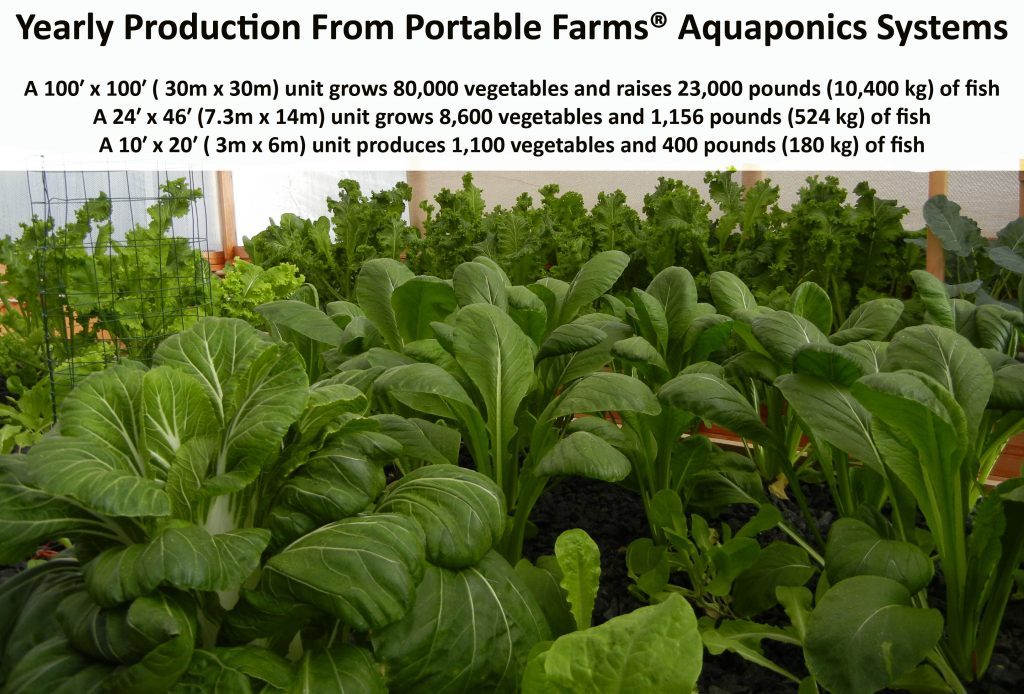
A variety of greens grown between 30 and 60 days. The basil and kale are 25″ tall.
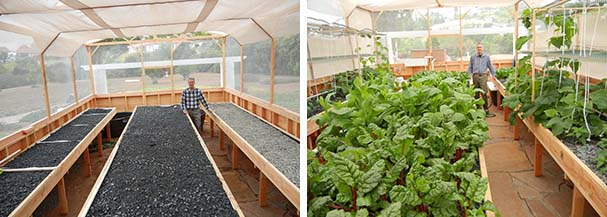
(left) A newly constructed Portable Farms® Aquaponics System prior to planting
or installing the fish in the fish tanks.
(right) 40 days after the seedlings were planted in the Grow Tables
and the fish were installed in the fish tanks.
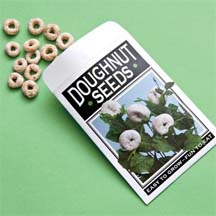
FOUR FUN FACTS ABOUT GROWING FOOD IN AQUAPONICS
- Portable Farms® Aquaponics Systems grow enough varieties of plants (greens and blooming plants), and protein (fish) to sustain human health to its optimum level.
- Portable Farms® Aquaponics Systems can feed your family or your community all the table vegetables and protein necessary to sustain excellent health FOREVER. PLUS, the systems are easily operated by semi-skilled labor, seniors, those with ambulatory disabilities (the grow trays can be made wheel-chair accessible height) and even responsible 14-year old can operate Portable Farms®.
- There have been over 300 different varieties of seeds and plants that have been tested that can be grown in a Portable Farms® Aquaponics System.
- The major food groups that are not recommended for Portable Farms are root vegetables (carrots, potatoes, onions, etc.) and corn, wheat, soy or rice. Perennial plants (strawberries, blackberries, asparagus, etc.) are not recommended because the plants are dormant 9 months per year and do not produce harvestable food year-round.
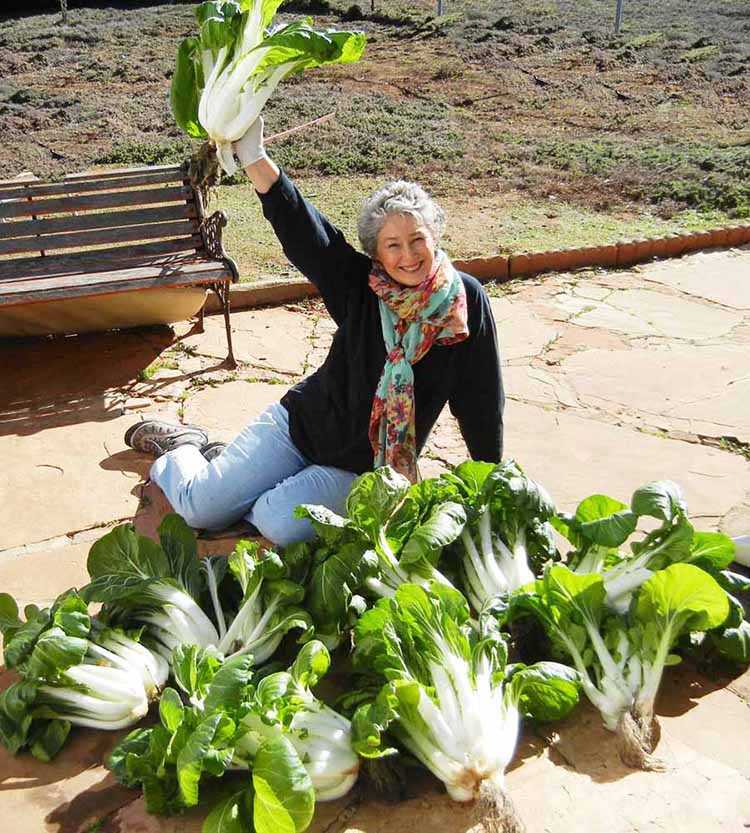
Phyllis Davis harvesting Bok Choy from a Portable Farms® Aquaponics System. The average
weight of the gigantic bok choys in this photo is 12 pounds 5 ounces.
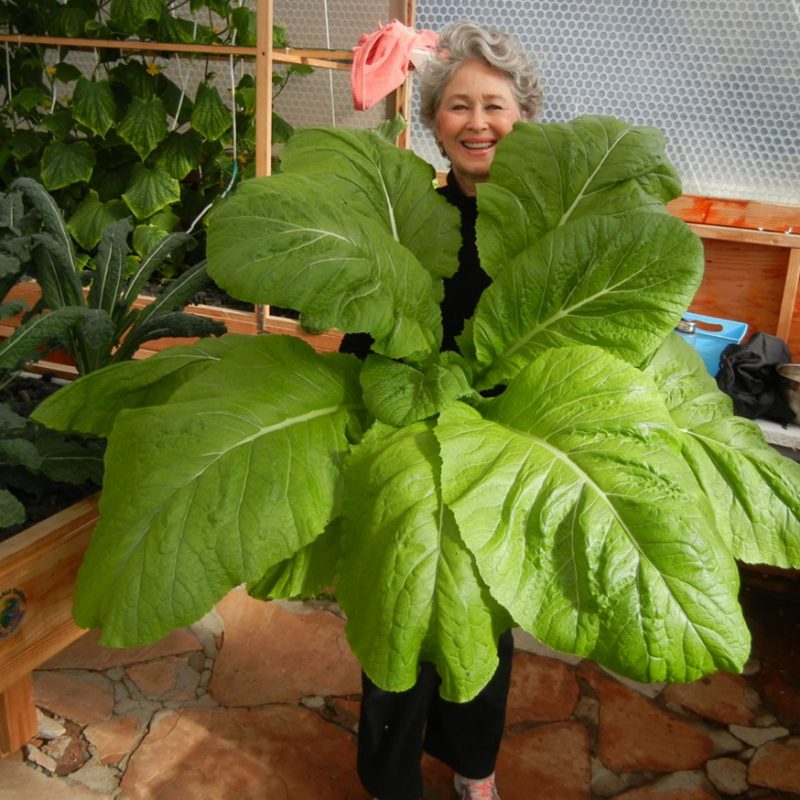
Phyllis Davis harvesting ONE SINGLE HEAD of India Mustard, an Asian Green.
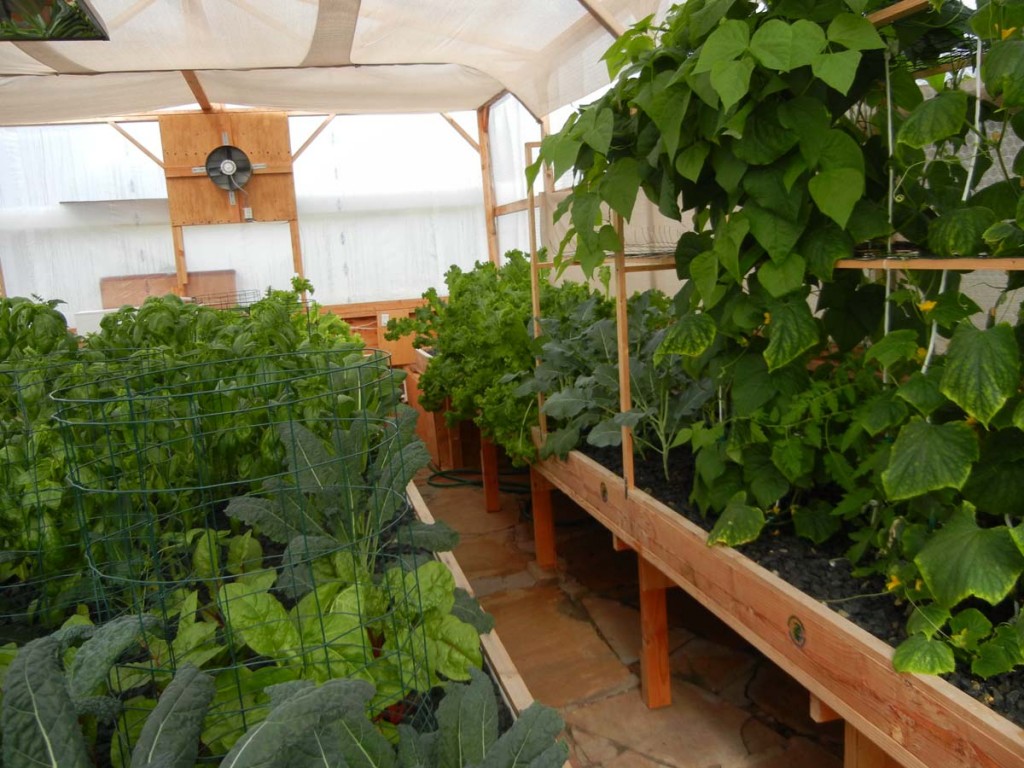
- Read about the Yield and Return on Investment for planting, growing and selling tomatoes.
- Read about the Yield and Return on Investment for planting, growing and selling zucchini.
- Read about the Yield and Return on Investment for planting, growing and selling peppers.
- Read about the Yield and Return on Investment for planting, growing and selling cucumber.
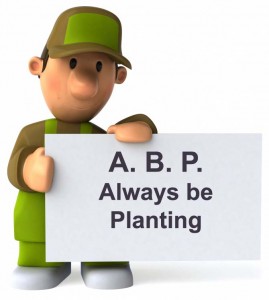
SIX SEXY SECRETS For a Successful Aquaponics System
- ALWAYS BE PLANTING. Every time you harvest a plant from your grow table, plant a new one in it’s place. Plant, harvest, plant harvest, repeat.
- PRAY FOR POOP. The fish poop is the precious nutrient stream that delivers the plants their food to grow tall, healthy and green. If your fish are happy, you’ll grow beautiful food. We even sing to our fish when we feed them and they love it. They begin to frenzy when they hear our voices. In fact, they’ll eat fish food out of our hand. They also enjoy consistent water temperatures of 78 degrees F.
- GOOD DAY SUNSHINE. Your plants need a minimum of six hours of direct sunlight. In winter months, we use grow lights to extend the available sunlight for an additional four hours per day.
- NO SMOKING AND NO SMOKERS IN THE GREENHOUSE. All forms of tobacco, smoke, vaping or nicotine will cause Tobacco Mosaic Virus, Cucumber Mosaic Virus and other blooming plant viruses.
- BUGS BE GONE. Since you cannot use pesticides in your aquaponics system (they’ll kill the fish), it’s important to make sure no insects of any kind (including ants) come into the greenhouse.
- WEAR GLOVES when you’re working in the greenhouse. This protects your plants and fish from your germs, pathogens, hand lotion, perfume, etc.
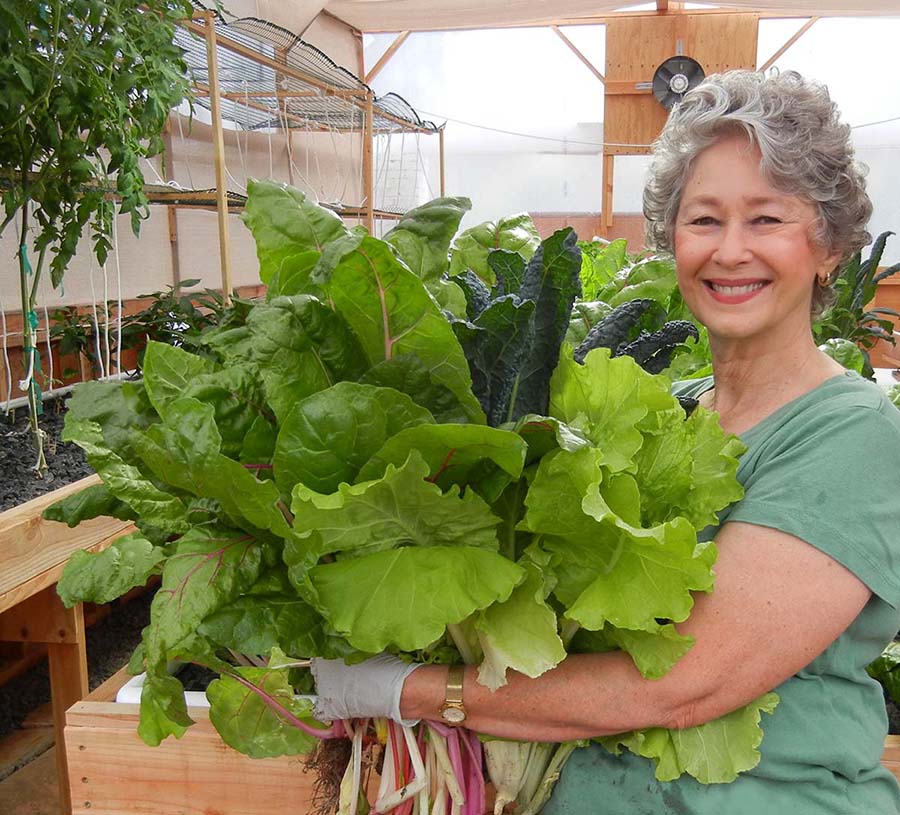
Phyllis Davis, Co-Inventor, holding a bouquet of ‘greens’ grown in this Portable Farms Aquaponics System in only 43 DAYS!
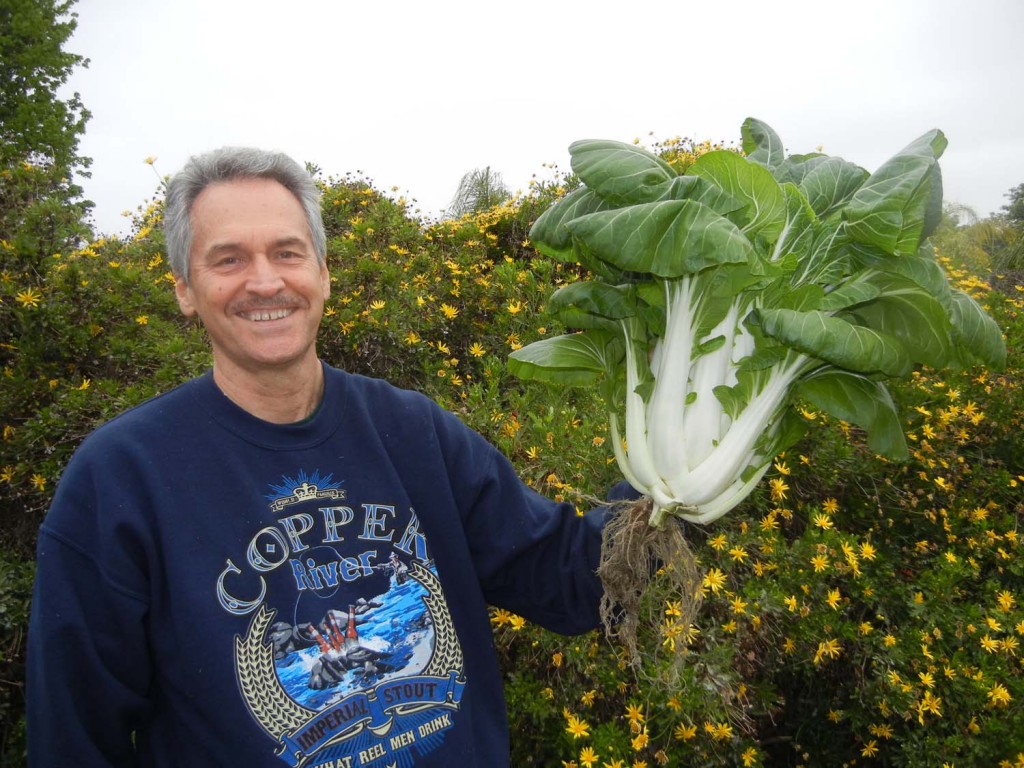
Colle Davis, Inventor, Portable Farms, holding a 20.5 pound head of Bok Choy grown in 45 days. WOW, now that’s a RECORD WEIGHT for growing!
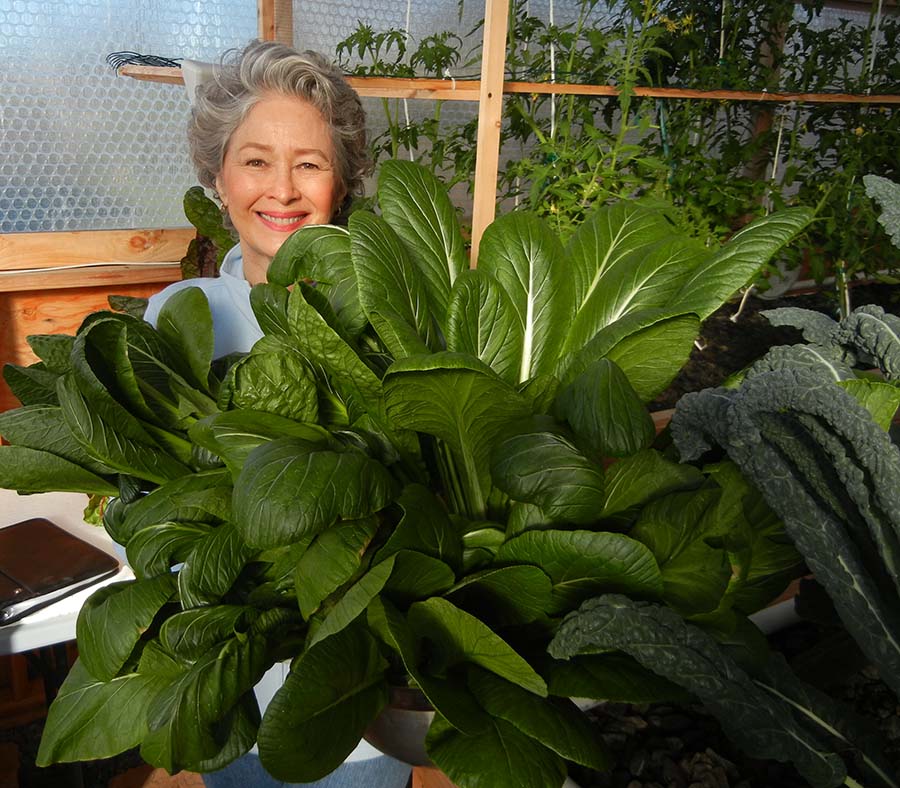
Phyllis Davis with several newly harvested plants of Japanese Mustard Spinach. It is a heat-tolerant plant that grows to harvest in about 32 days. It is used in salads and stir fry. It grows very large and lush in Portable Farms® Aquaponics Systems. This plant’s leaves (in photo above) measure 23″ tall and 6″ wide.
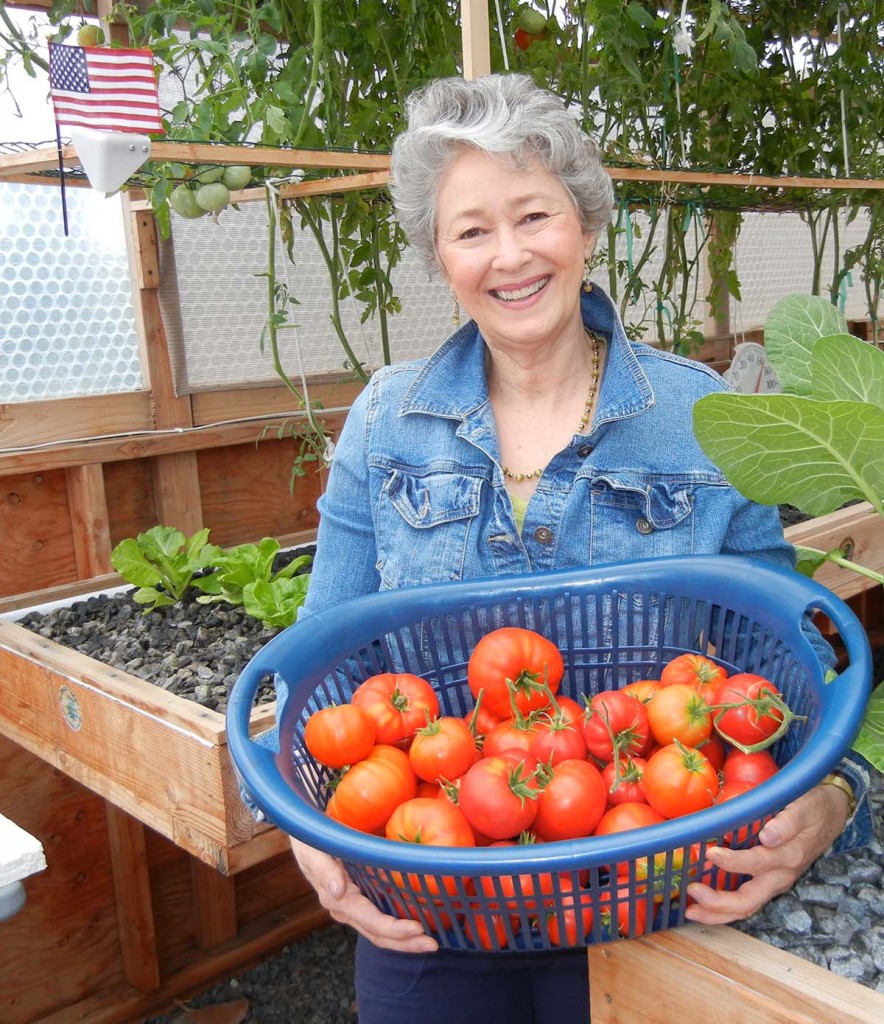
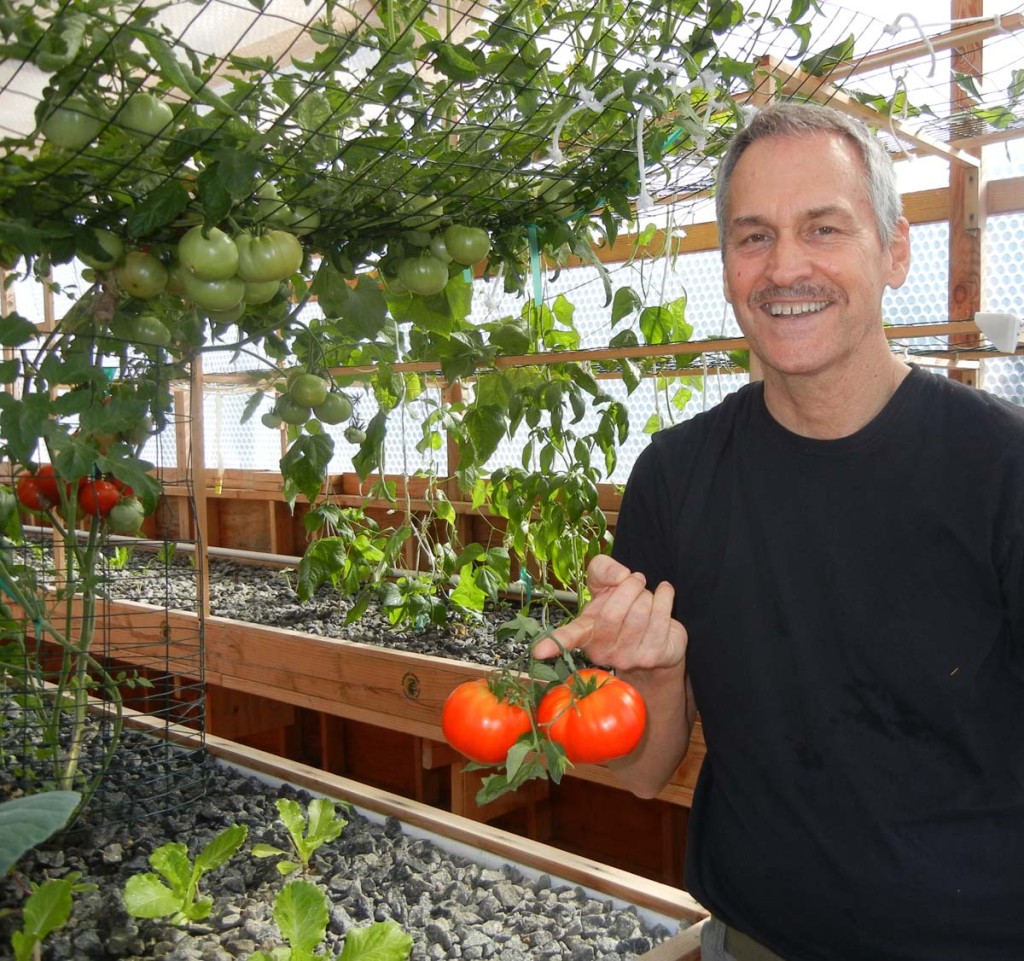
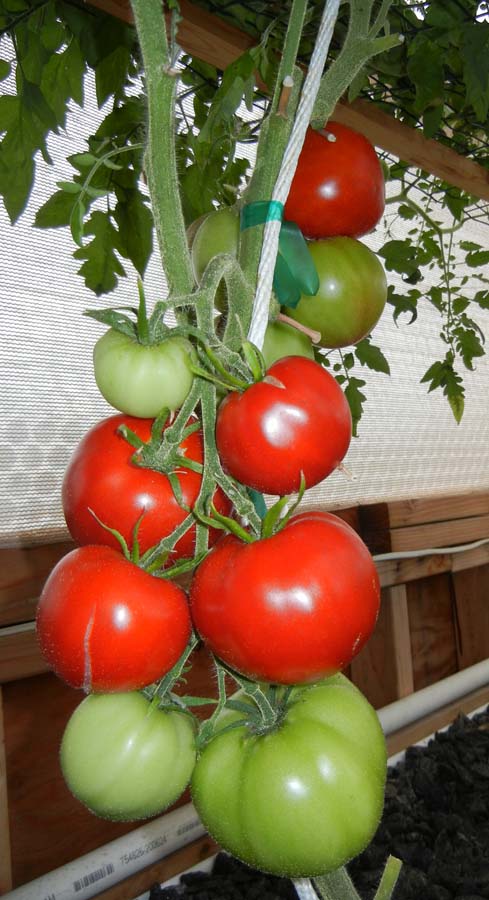
Tomatoes, oh yum.
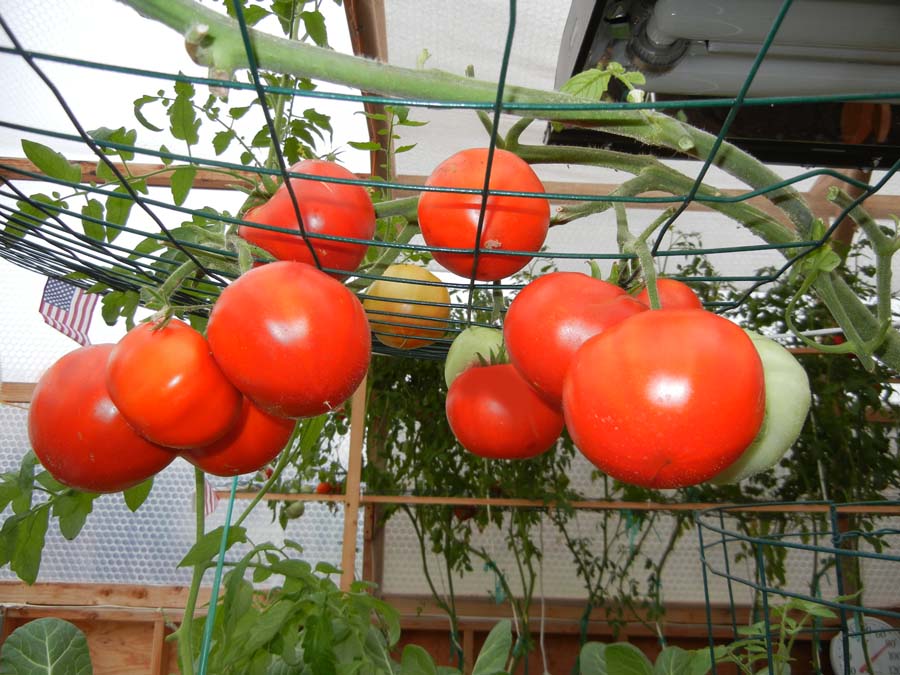
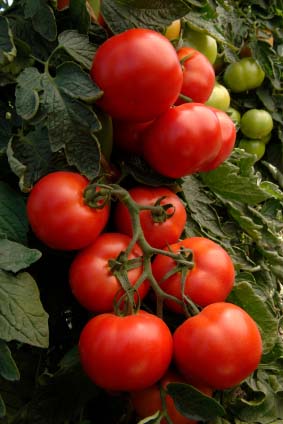
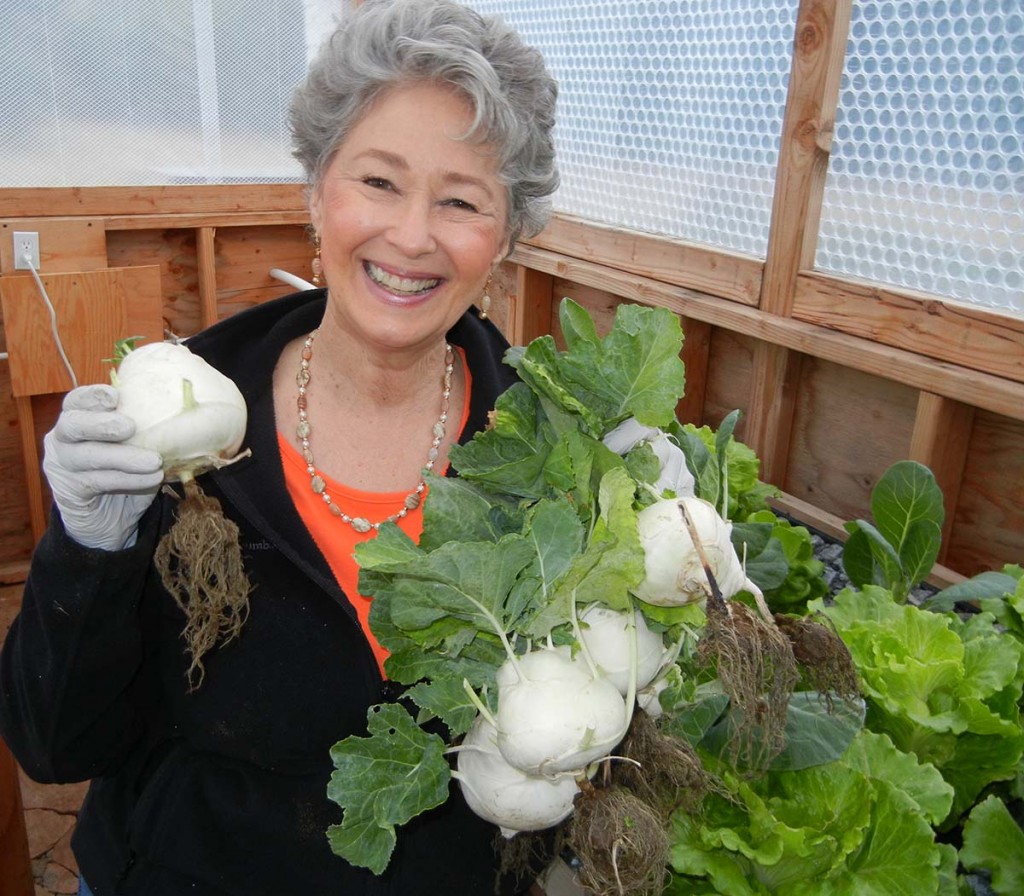
Phyllis Davis harvesting several kohlirabi. Kohlrabi is similar to the cabbage family with a taste much like a broccoli stem. Can be eaten raw or cooked.
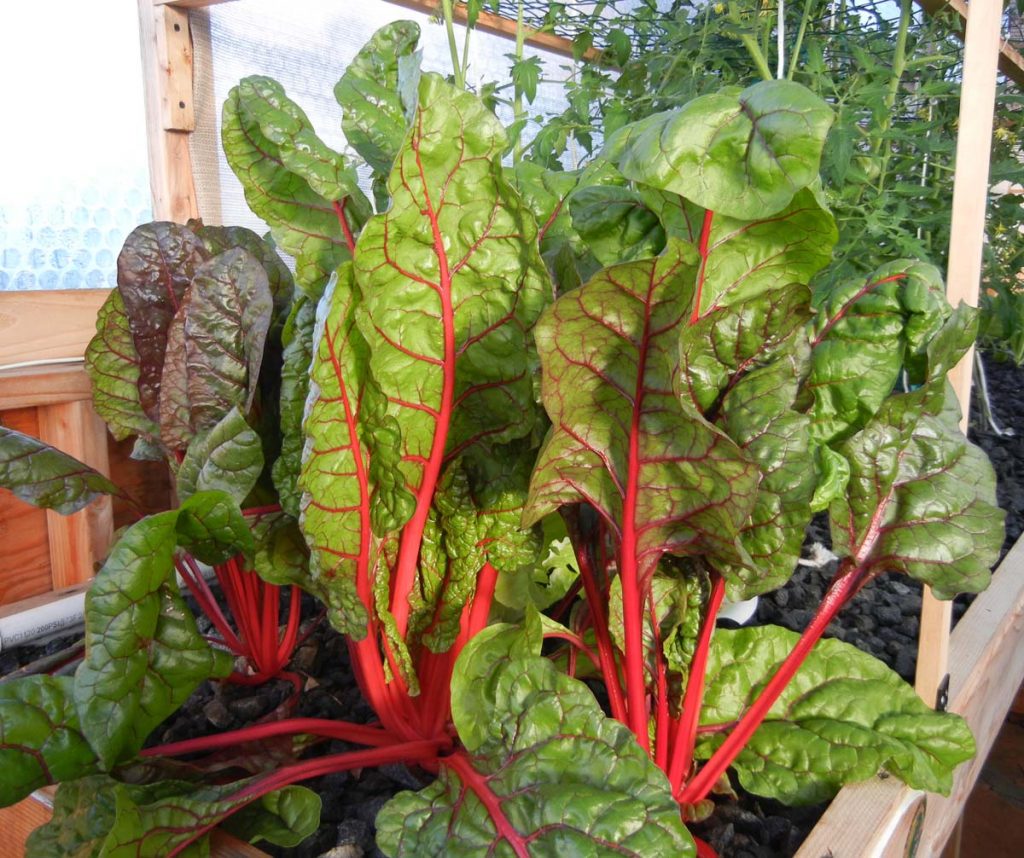
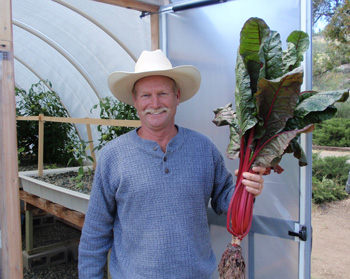
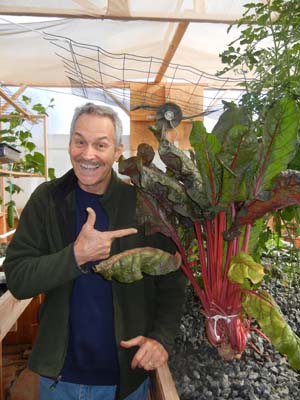
(left and right image) Colle Davis and Lane McClelland posing with very large single heads of Swiss Chard grown in a Portable Farms Aquaponics System.
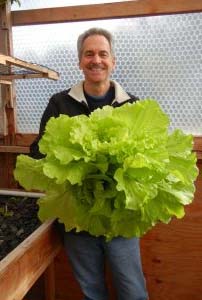
(left and right image) Colle and Phyllis Davis harvesting single heads of Komatsuna Summerfest, an Asian green we prefer over all other lettuces. It grows beautifully in Portable Farms.
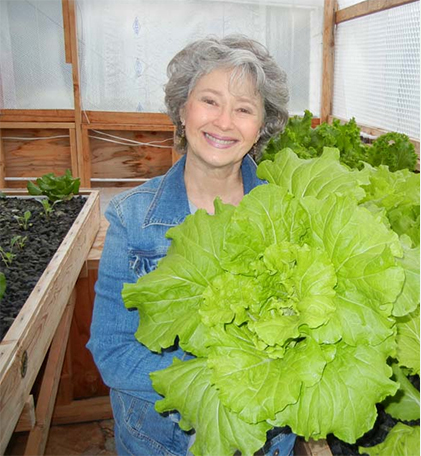
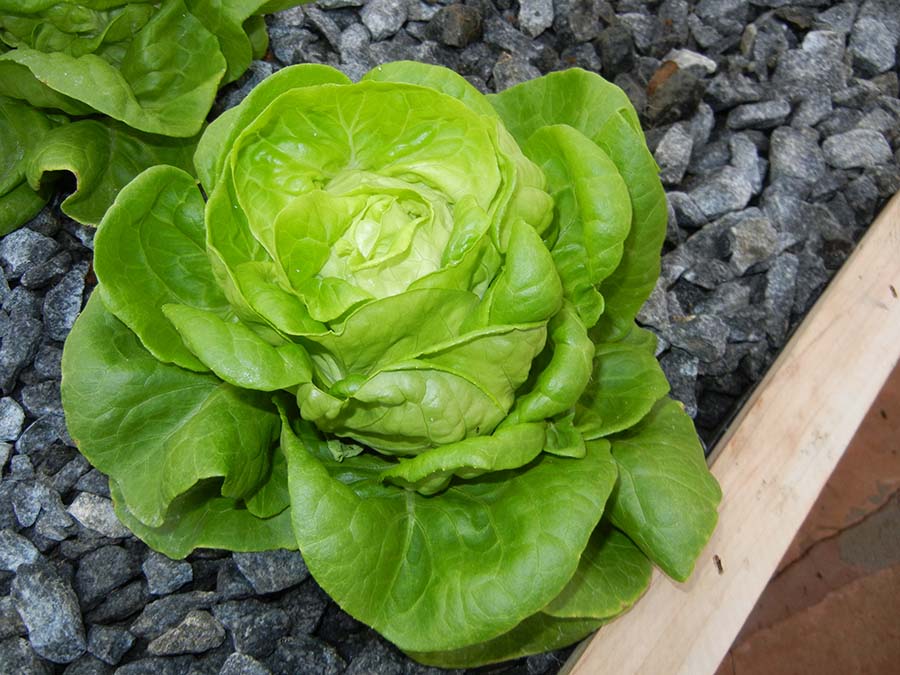
Butter leaf lettuce ready to harvest that is 12″ in width.
Tender, delicious and rich in flavor.
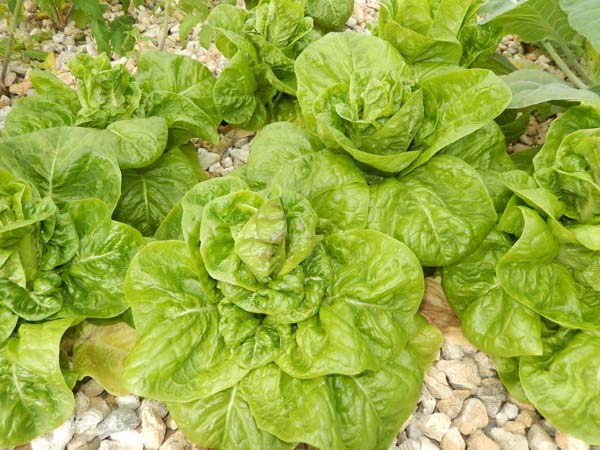
Greenleaf lettuce, 9″ in width. Buttery, tender and delicious.

Phyllis Davis holding 8 heads of kale just harvested from a
Portable Farm. The average height of these kale is 47″. Monster kale!
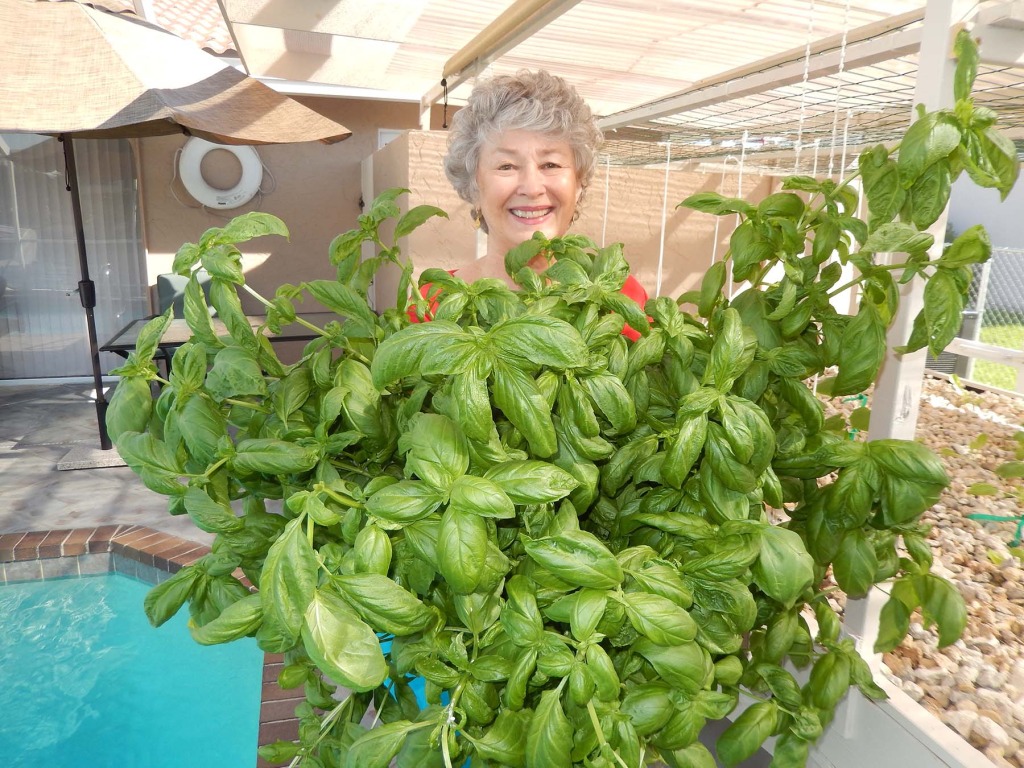
Phyllis Davis harvesting basil that is 52 days old. We ‘cut back’ our basil once after harvest to regrow again before we remove from Grow Tray. This basil was grown in a solar-operated Portable Farm in an screened-in porch (lanai) in Southern Florida.
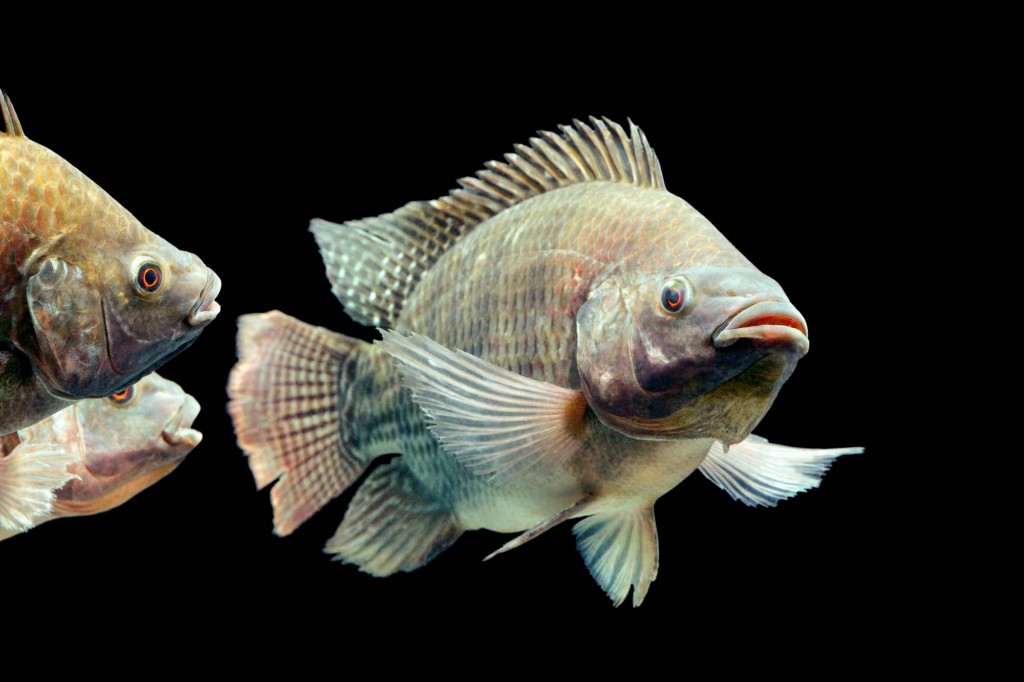
Plus, fish tank-raised fish are vital to aquaponics. We recommend Oreochromis Mossambicus Tilapia. It’s a mild white fish that we harvest in 7 to 9 months when they weigh 1.25 pounds and produce 2 four-ounce fillets.
Fresh Tilapia fillets. FISH: Tilapia is a low-fat, white-fleshed fish that is sweet, fine-textured and doesn’t taste fishy. Enjoy your Tilapia by baking, broiling, grilling or steaming it.
The history of Tilapia can be traced back over 4,500 years to Ancient Egypt with its origins in the Nile River. Tilapia has been called St. Peter’s Fish since early Biblical times because it is believed to be the fish that Jesus fed the multitudes in the biblical parable.
The fish used in your Portable Farms® Aquaponics Systems are hybrid Tilapia or catfish, or perhaps several fish depending on availability and your State regulations. We recommend hybrid Tilapia. Please note: We don’t recommend growing trout, bass, salmon, and other fish because they prefer cold water. The plants in Portable Farms® prefer warm water so we supply our systems with a fresh water/warm water fish.
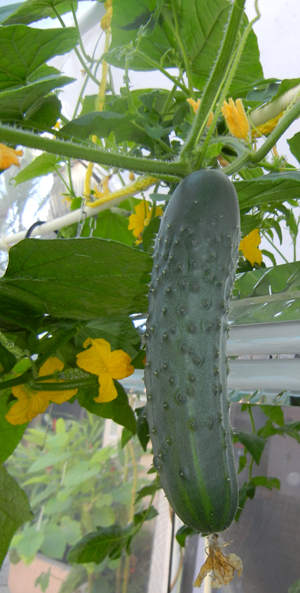
Cucumbers grow well in Portable Farms Aquaponics Systems.
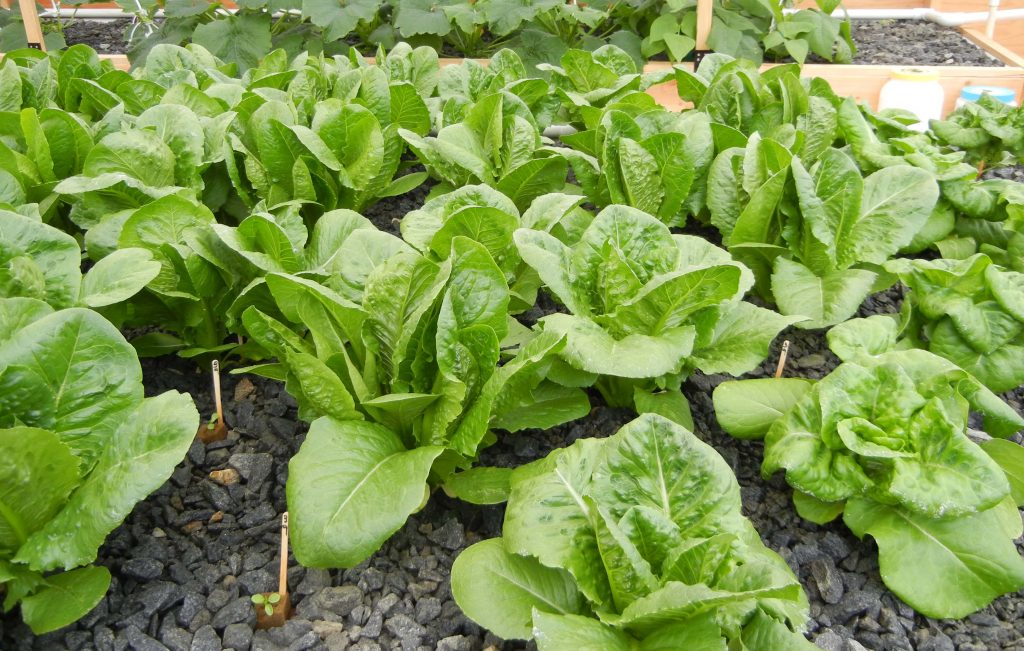
Romaine lettuce growing in a Portable Farm in 44 days. Note the two plantings (look for two sticks in left foreground.) The magic words in aquaponics are ALWAYS BE PLANTING.
Harvest then plant. Harvest then plant. Repeat.

Peppers of all varieties grow well in our Portable Farms! Some like it HOT.
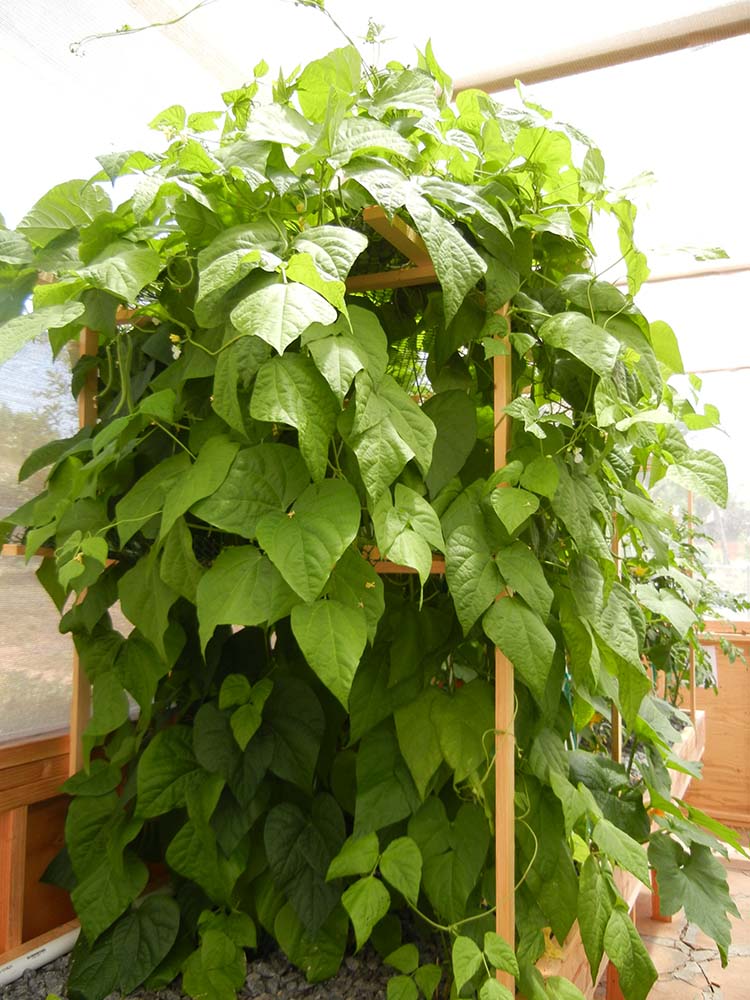
These six green bean plants that produce over 250 green beans. This variety blooms again after harvest and produces a generous second harvest within 2 weeks after the first harvest.
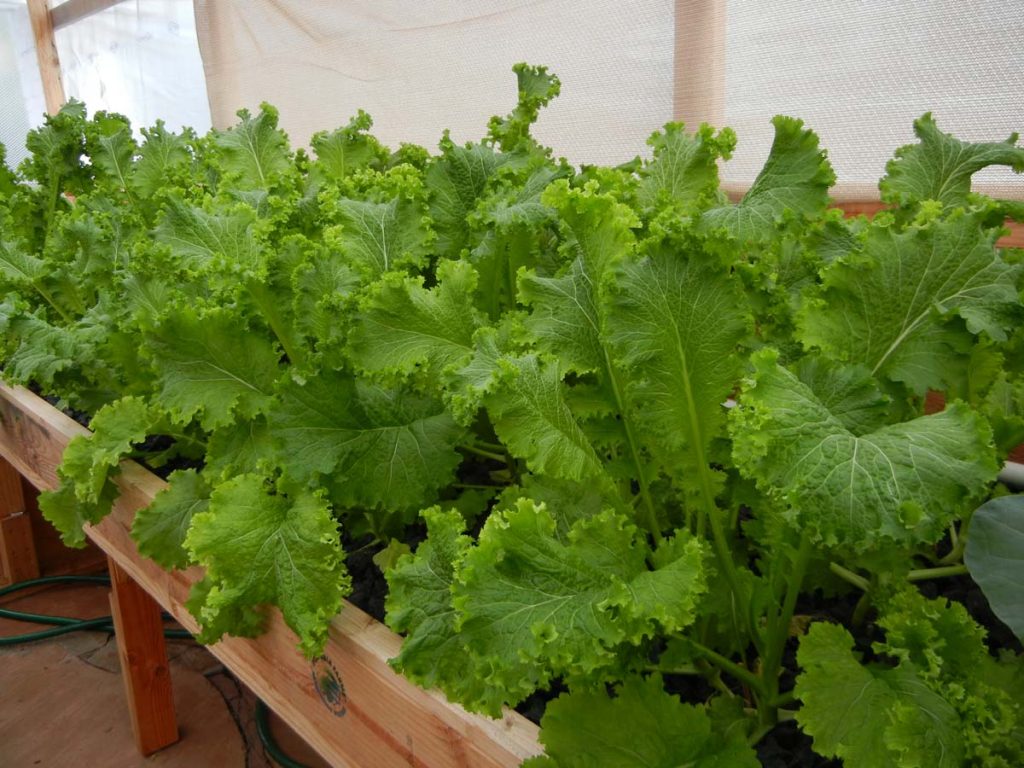
(right and left image) This is a hot and spicy lettuce we call Wasabi Lettuce. It’s actually called Green Wave Lettuce.
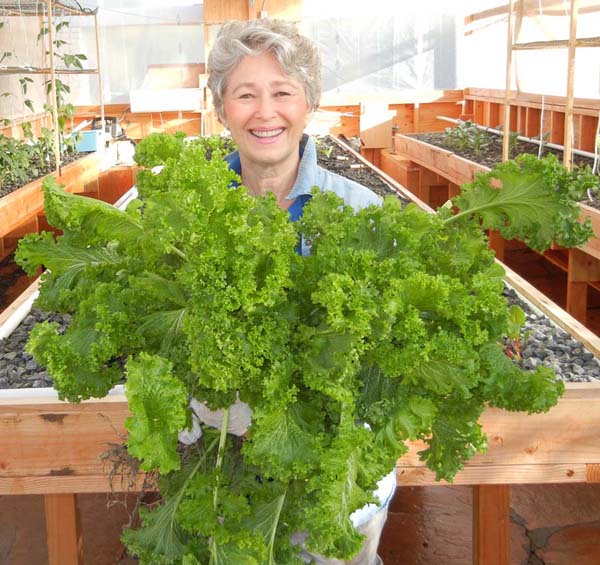
SIX SEXY SECRETS For a Successful Aquaponics System
- ALWAYS BE PLANTING. Every time you harvest a plant from your grow table, plant a new one in it’s place. Plant, harvest, plant harvest, repeat.
- PRAY FOR POOP. The fish poop is the precious nutrient stream that delivers the plants their food to grow tall, healthy and green. If your fish are happy, you’ll grow beautiful food. We even sing to our fish when we feed them and they love it. They begin to frenzy when they hear our voices. In fact, they’ll eat fish food out of our hand. They also enjoy consistent water temperatures of 78 degrees F.
- GOOD DAY SUNSHINE. Your plants need a minimum of six hours of direct sunlight. In winter months, we use grow lights to extend the available sunlight for an additional four hours per day.
- NO SMOKING AND NO SMOKERS IN THE GREENHOUSE. All forms of tobacco, smoke, vaping or nicotine will cause Tobacco Mosaic Virus, Cucumber Mosaic Virus and other blooming plant viruses.
- BUGS BE GONE. Since you cannot use pesticides in your aquaponics system (they’ll kill the fish), it’s important to make sure no insects of any kind (including ants) come into the greenhouse.
- WEAR GLOVES when you’re working in the greenhouse. This protects your plants and fish from your germs, pathogens, hand lotion, perfume, etc.

82 comments
Skip to comment form
I’m so happy I found your website. I’ve just been approved for financial assistance and I’m going to start my own business in Aquaponics. It quite some time to decide what type of business but through research and prayer this is what I believe I will be passionate about just as you are, you can see it in your faces and your big beautiful plants. God put this on my heart so I pray to be as successful as you are. Ya’ll are such a joy. I’m in Houston Texas where the weather is a lot like Florida.
Much success and happy harvesting
Bobbie Benge
Author
Bobbie,
The best of luck to you in all of your endeavors. The company PFAS LLC is being sold and we no longer sell the Portable Farms systems.
How do you keep ALL insects out of the green house?
Why are root vegies not recommended?
We spray our plants with Worm Casting Tea (natural product) to increase the health of our plants. When we see an ant, we search outside the greenhouse to find the hill and we pour boiling water in the hole.
We don’t grow root vegetables because there is no soil in the farm. We grow in 3/4″ granite gravel and the plants cannot emerge from the gravel. For example, carrots, potatoes, etc.
Phyllis Davis
Can I use a shipping container to house the system? I am looking to set one up on a small Cay in the Abaco Islands, in Bahamas, and we have wind that will destroy a greenhouse.
Author
Wayne – Thank you for your interest in Portable Farms.
We don’t recommend shipping containers in warm climates because the interior heat from the metal cooks the plants. Plus, you must use grow lights in the shipping container because there is no natural sunlight and the grow lights also create heat. Plus the grow lights must be turned on 18 hours per day and the electricity for 18 hours is very very high.
Sorry not to offer you better news.
Phyllis Davis
President, PFAS LLC
is it suitable for cold weather countries like Norway? temperature in winter can reach minus 30 degree
Author
Colle Davis replied to your question by email. Thanks for your interest in Portable Farms Aquaponics System.
Has anyone ever tried growing cannabis with your system? Thanks
Author
TJ – We have not ‘seen’farms growing cannabis and we’ve never grown it, but we believe many of our customers have done so. Cannabis likes growing in a a drier medium and we have made suggestions for modifying our systems to meet their growing needs. – Colle Davis, CEO, PFAS LLC
I am interested in purchasing your system, but would rather raise trout. Is this possible to change the “settings” to adapt to trout’s needs? We are in Northwest Wyoming.
Author
Anna,
Yes, with the caveat the vegetables may not be as happy in cooler water. Most of the PFAS installations run temps in the 70’s and 80’s in the summer time and trout are not happy or healthy at those temps. It can be done, carefully.
Best of luck to you.
Colle
Author
Anna: We are having a sale- August 2 – 6, 2021. Visit the link to learn more: https://portablefarms.com/2021/portable-farms-sale-august-2-6-2021
Our NEWLY REVISED 2021 ONLINE self-paced aquaponics course contains all we’ve learned in our 49 years in the field of aquaponics and includes a Portable Farms® Kit containing the technology that is the ‘heartbeat of the system’ that allows our systems to grow such beautiful food and healthy fish.
In celebration of Portable Farms® 13th Year Anniversary, we’re offering
the sale of One Portable Farms® Course and Kit for $1,399.00.
Buy one Portable Farms® Course and the Kit – $1,399.00
or Buy Two Portable Farms® Courses and Kits – $1,999.00
O’fish-ally Your Friends,
Phyllis and Colle Davis
Hi,
My wife and I are purchasing a home on 5 acres in a few months. I’d like to look into buying 2 of your kits to start, but would like to keep it the grid-energy consumption as low as possible. We plan to use geothermal energy to heat and cool the greenhouse. The desired spot for the greenhouse will be around 70 yards from the house, so I plan to run electricity to it for extra light, heat, and fans when we need it; we live in NE and have cold winters. I want to utilize clean energy as much as I can. Can you elaborate on your Solar Portable Farms?
Thanks,
Dan
Author
Dan,
The Solar Option contain the same equipment as the regular Portable Farms Kit with three exceptions; the timer is 12volt, there is an inverter 12vdc to 120vac to run the 120vac air pump for the CAD Pump and the smaller air pump is 12vdc. We ran our systems in Florida on a single 100w panel with grid current to run the fish tank heaters. You will need to heat the fish tank in some manner to keep it near 80F. When building the structure the more insulated the better. Insulate the north side and roof w/6 to 8″ of insulation. Insulate the bottom half of the end wall up to 4 ft the same way.
Keep us posted on your progress and we look forward to having you as students.
Colle
Author
Dan: We are having a sale- August 2 – 6, 2021. Visit the link to learn more: https://portablefarms.com/2021/portable-farms-sale-august-2-6-2021
Our NEWLY REVISED 2021 ONLINE self-paced aquaponics course contains all we’ve learned in our 49 years in the field of aquaponics and includes a Portable Farms® Kit containing the technology that is the ‘heartbeat of the system’ that allows our systems to grow such beautiful food and healthy fish.
In celebration of Portable Farms® 13th Year Anniversary, we’re offering
the sale of One Portable Farms® Course and Kit for $1,399.00.
Buy one Portable Farms® Course and the Kit – $1,399.00
or Buy Two Portable Farms® Courses and Kits – $1,999.00
O’fish-ally Your Friends,
Phyllis and Colle Davis
do you have cold water systems as well?
Author
Our plants prefer 78 degree F water, not cold water.
Hi Cole,
I intend to raise tilapia and cat fishes uaing your system.
Can upumprovide an honest recommendation for the suitable system to purchase for usage?
Hope to hear from you timely.
Thank you
Author
Olanrewaju,
The Portable Farms Aquaponics System will do nicely. There is a sale going on now. Check the website and aquaponicsuniverity.com
The Aquaponics University Course included the Portable Farms Kit to help get you started.
Colle
I have extremely cold temperatures and a lot of snow. How does a greenhouse plans look?
Author
The structure need to have R30 walls on the north side, the back half of the east and west wall, and any roof facing north. The higher the insulation R factor the better. The front (south facing) wall is best suited to be insulated up 4′ also.
The roof needs to be designed and build to carry the snow loads for you area.
Taking all of these factors into consideration you can have a successful Portable Farms installation almost anywhere.
You will also need grow lights to extend your daylight.
We trust this help.
Author
Olanrewaju: We are having a sale- August 2 – 6, 2021. Visit the link to learn more: https://portablefarms.com/2021/portable-farms-sale-august-2-6-2021
Our NEWLY REVISED 2021 ONLINE self-paced aquaponics course contains all we’ve learned in our 49 years in the field of aquaponics and includes a Portable Farms® Kit containing the technology that is the ‘heartbeat of the system’ that allows our systems to grow such beautiful food and healthy fish.
In celebration of Portable Farms® 13th Year Anniversary, we’re offering
the sale of One Portable Farms® Course and Kit for $1,399.00.
Buy one Portable Farms® Course and the Kit – $1,399.00
or Buy Two Portable Farms® Courses and Kits – $1,999.00
O’fish-ally Your Friends,
Phyllis and Colle Davis
If I sign up for the course do you receive any components for the structure?
Author
Rich,
Upon completion of the AU Course you receive a Diploma and the Portable Farms Kit. The kit contents are listed here http://portablefarms.com/thank/pfapl.pdf .
Colle
Hello
Can one add commercial shrimp/prawn farming in your system? Would you recommend it? Looking forward to being your student soon.
Thanks
John
Author
John,
Yes. We do not have enough experience to say one way or the other.
Colle
Hi,
I am interested to grow Rice along with Aquaponics, However in your recommendations on things to grow, you don’t recommend Rice or Wheat. Could I request you to elaborate more on the reasons? What if we use Hydroton as the grow bed media? Would we be able to grow Rice then?
Looking forward to hear from you.
Regards,
Sagar
Author
Sagar,
Sorry for not being clearer about the function of the Portable Farms® Aquaponics Systems. Rice is a field crop and you could not grow enough rice in a year for one person for a month in the Portable Farms. Same with wheat, a field crop, cheap carbohydrates. The Portable Farms® Aquaponics Systems are designed to grow greens and table vegetables.
Hydroton is very expensive and very nearly floats. Gravel is recommended, it is available everywhere in the world, is cheaper and easy to work with in the Grow Tables.
We look forward to having you as a student.
Colle
Is it really true you can’t grow strawberries year round? Saw this website that said that the Day Neutral varieties produce year round.
http://www.h2ogrowing.com/growing-hydroponic-strawberries/
Author
Robert,
The reason for not growing strawberries in the Portable Farms has nothing to do with Day Neutral or variety. Strawberries are not grown from seeds, but from tiny plants and one is NEVER to bring any plants you have not started yourself from seed into the Portable Farms® Aquaponics Systems because you risk importing soil or substrate pathogens into your system. Our biggest aphid infestations were from strawberries and a gift plant from a very dear friend that we planted in our Grow Tables. It took us weeks to clean up our own self inflicted problem. In the AU Course this restriction is spelled out very carefully. Thanks for asking.
Colle
Dear Colle and Phyllis,
What a wonderful job you have made. There are so many things about aquaponics on the net but your site really gives me the will to try my best.
I live in DRC Kinshasa for 25 years, where most of quality vegetables are imported by plane from South Africa and Europe, so you can imagine local prices for those products.
Local production is very poor as they are no possibility to develop technologies and increase quanity and quality of production.
My wife and I have a small space 1500m2 we would like to use to begin aquaponics. 30 Kms away from the capital city Kinshasa.
I’m aiming to produce tilapias, as congolese love that fish and we’d like to grow Lettuce with floatting rafts cherry tomatoes with dutch buckets and Bok Choy as the chinese colony in DRC is more and more important and they can find their favourite vegetable around 25 dollars a Kilo… We plan to use the Congo river water next our yard.
Unfortunately, local banks and NGOs in DRC won’t follow us and we’ll have to get it started the Do It Yourself way.
As soon as our small project gets results and we can provide numbers, we are sure to get more funds in the future for bigger installations using different aids.
I wish I could achieve in the next 12 months so we may use those results to expand and ask you guys to go the next professional step.
We know a lot of people here who will follow our green production, thinking about internet vegetables baskets, supply restaurants, hotels and supermarkets… we are 30 km away from the capital city
Can you help us to go on the first step as we need to get experience first before going on a more professional and bigger step, that we hope with you guys?
We have plenty of interesting productions to think like strawberries, flowers, basil, pepper and many others, I wish I could invite you guys here so you can see what I am talking about.
Willing to read you, I congratulate you again for your achievements.
Best regards,
Laurent.
Author
Pecriaux,
Thank you for the very nicely done letter. We do our best.
Our new book Commercial Aquaponics GOLD> is the place to start for commercial aquaponics anywhere in the world. It takes your from concept, to market survey, to site prep, to building to production. It also includes a business plan template and the Executive Summary with all the cost, expenses, production and profits laid out for you to use with funders.
If you simply need to get your hands wet and get started then purchase the new Backyard Aquaponics GOLD book.
The need to start small is not a deterrent, it is how to learn the technology and become familiar with the market, the crops and the growing process.
Good luck and keep us posted on your progress.
Colle
Dear Colle,
Thank you for your prompt reply.
We sent you an email so we can definitely start our project.
Laurent.
Author
Laurent,
Thank you for the follow up. We look forward to watching your project come to fruition.
Colle
Hi, I am from South India and very impressed on your technology in farming. Reagrding fish, its very difficult to find Tilapia fish in India so can you let me know what kind of fish we can use in India?
Author
Tej,
Any warm water, freshwater herbivore fish can be used. Tilapia are available everywhere in the world. You can order a breeding colony to have your own stock breeding available.
Colle Davis – Inventor
Thank you very much for your quick response. Can you please let me know if this system has installed in India? If so how are the results?
Thank You!!
Author
Tej,
There are number of students of Aquaponics University who have successfully installed the Portable Farms® Aquaponics Systems in India and other parts of the world. Many of these installation are producing at or, in most cases, above the expectations of the owners. The key is to have a climatically adapted structure to house the PFAS. We recently completed an installation in Florida, USA and realized that the reason very few vegetables are grown in Florida in the blazing heat of summer is that growers do not use shade cloth, a critical component for the success of a Portable Farms® anywhere in the world. Keeping the rain out of the Grow Tables and the insect out of the structure are the two most important facets that must be addressed in building the installation.
We trust this helps is some way to move your project forward and we look forward to having you as a student.
Colle Davis – Inventor
Hello, I would like to know if you sell Portablefarms to South America.
If I am right, the weather is not an obstacle for the farms.
Thanks.
Author
Maddalena,
Yes, we sell Portable Farms® Aquaponics Systems in South America. However, unless you are purchasing a commercial installation, 1,000m2) you will have to take the Aquaponics University Course in order to receive the PFAS Kit. The installation must be in a climatically adapted structure, meaning that the temperature must be kept between 8 and 40 C, the building must be screened and made so the rain will not fall on the Grow Table, all for the health of the plants and fish.
We trust this helps.
Colle Davis – Inventor
Hello.
My name is Monicah from Kenya, and I am very interested in undertaking commercial aquaponic farming.
Do you have any farmers in Kenya under your programme? if not, what are the requirements for being a distributor?
I have ten acres of land, and would want to do large scale commercial aquaponics,where do I start?
Kindly email me directly.
Looking forward to your response
Author
Dear Monicah:
Thank you for your inquiry regarding the possibility of installing Portable Farms® Aquaponics Systems in Kenya.
There is a multi-step process which allows PFAS LLC to best serve you and your investors by presenting information to support your efforts.
Below are the steps PFAS LLC requires in this information gathering process:
Greenhouse Special Report on The 5-Phases of Commercial Growing
To better assess your project and offer you the answers that are timely and relevant to YOUR specific needs, please answer the following general questions related to you and your project and we’ll get back to you quickly.
Please note: PFAS LLC receives hundreds of emails, inquiries and phone calls per week from over 170 countries and we respectfully request your professionalism in responding to our requests in order to receive this valuable .pdf document, Special Report on The 5-Phases of Commercial Growing. If your contact information is not adequately provided and your answers are not fully stated in your email to us, we will not respond to your request for the document that is adequate to present to investors or business partners. Thank you very much. – Colle Davis, CEO, PFAS LLC
This special report, The 5-phases of Commercial Growing explains the costs associated for installing a single 10,000 sq. ft. aquaponics Unit and also included are the costs for one acre and one hectare.
Please copy/paste the following bolded information into the body of an email to request The 5-phases of Commercial Growing and after you have completed the requested information, EMAIL it to this address.
Your name:
Company Name:
Company Website:
Home or Company Street Address: City, State, Country, Zip:
Email Address:
Best phone number to reach you:
Six Questions:
1. What size project is your group planning to build? ¼ acre? 1 acre? Etc.
2. What state or country is your project targeted for installation? Please be specific.
3. What is your projected time frame to begin your project? 90 days? One year? Etc.
4. Have you and your company ever operated a successful business for over four years?
5. Do you or your company have access to the funding required for this project? If not, do you have a target date for that available funding for the project?
6. Have you explored the marketing study for selling the food Portable Farms® is capable of growing?
2. After reading the documents we provide you with the document 5 Phases for Commercial Growing to move your project forward, you may also at that time, request a Mutual Non-Disclosure Agreement between your company and PFAS LLC.
3. After we have both signed this Mutual NDA, we will send you the PFAS LLC Executive Summary containing some of the information you will require to prepare a Business Plan. PFAS LLC can also provide you with a Business Plan Template. We do not provide statistics, or figures in the Business Plan; you are required to provide that information to complete to present to funders.
4. Prior to the preparation of your Business Plan, you will need to complete an exhaustive marketing study in your marketing areas in Kenya where you will install your Portable Farms® Aquaponics Systems and where you can ‘sell your food’ on the day it is ready for harvest. No investor or funder will entertain a Business Plan without a very thorough marketing study.
The smallest commercial aquaponics system we recommend is 10,000 sq ft greenhouse with 6,000 sq ft growing space (1/4 acre). The total for the greenhouse (varies according to climate) and our technology is about $300,000 per 1/4 acre . . . and $1 million per acre. There are many factors that determine the return on investment for an investment of this size, but generally it is between 2 and 4 years depending on the customers you have and the types of food you provide them (some crops are more valuable in and out of season) and the skill level of your operators.
Please note, we receive hundreds of inquires per month and we do our best to educate our potential customers so please be patient as we go through the process necessary to provide you with the information required to move forward with your project. The Portable Farms® website has over 400 articles about aquaponics and we recommend you study our website and learn all you can of the basics and the terminology involved in the process.
Thanks Monicah and we look forward to working with you.
Your friend,
Phyllis Davis
President, PFAS LLC
Hello,
I am in Uganda East Africa, if I grew vegetables how easy is it to find an international market?
A place where i can sell my produce.
Author
Henry,
We never support selling into the international market. The Portable Farms® Aquaponics Systems are for raising the best locally grown, pesticide free food in the world. The key is LOCALLY GROWN. Because you can harvest at the peak of the plant’s time, shipping is not a good idea. We tell everyone who inquires that they must develop their LOCAL market for the output or we ask them to please use some other system. The PFAS produces only for the local high end market.
Colle Davis – Inventor
Hello, I live in Texas and am very interested in aquaponics. I would like to raise crawfish instead of fish. Would that be possible with your system? If not, can you give me reference to whom I may contact?
Thanks!
Author
Tina,
Crayfish work well. In Texas you are restricted to native species. They are detritivors and are often raised under the other fish. The only restriction is securing a year round supply of babies. If you can work around that, go for it. Good luck.
Colle Davis – Inventor
Hello,
I live in an island in the Caribbean, and I have heard so much about this system. There are some limitations on no native fishes like tilapia, which is commoly used in this system. I am wondering if it will be productive and profitable if I only focus on the vegetables production and not in the raise of fish. And use local fish, without really going further in their growth cycle, but just used them for the amonia, aegle and nutrients necessary to produce vegetables? I am still looking for a system that requires less use of energy and water plus the growth rate is higher. Does it matter the type or fish? or do they need specific characteristics?
Author
Maria,
Not raising fish means you have to dump chemicals into the water to feed the plants, its called hydroponics. You can use any warm water, freshwater, herbivorous fish. Gold fish, catfish, carp all work. Keep looking if you feel that our system, which requires the least amount of power of any aquaponics system in the world, requires too much electricity for you.
We trust this information is helpful. You really need to take the Aquaponics University Course first so you can be successful with aquaponics.
Colle Davis – Inventor
Hello,
Is there anyone experienced planting lemon and lime in aquaponic. Lemons are on high demand on our market and we are considering to plant lemons. What is the production and how long willl it take to harvest lemons and limes?
Author
Zulaa,
Perennials require too much space to be grown in controlled atmosphere environments. The short answer is yes, probably, BUT it requires a very different arrangement than the Portable Farms® Aquaponics Systems. We have no information on ‘orchard’ aquaponics, sorry.
Colle Davis – Inventor
I live in Michigan. Tilapia is a warm water fish. Wouldn’t perch be a better choice here?
Author
Jason,
Perch is a great choice, but we have never raised them so currently, unless you want to be the research center and do the work yourself, we do not recommend them. Besides plants do not like cold or cool water, it slows their growth dramatically.
Colle Davis – Inventor
Do you have any operations in Canada or specifically in the Calgary, Alberta region
Author
Dean:
Yes, we do have operations in the Calgary area but they are not available for tours. – Phyllis Davis
I live in Georgia and am a member of a farm co-op. I am wondering is there is something that you can mill to me so I can interduce the program to the group?
Author
Maxine: You can request 5 phases for Commercial Growing by answering the six questions on the front of our webpage and sending them back to us so we can supply you with the correct information for your specific project. This document explains the process for installing commercial aquaponics systems. Then, after completing the six questions, send the answers to the email address provided in the area with the six questions. – Good luck and happy growing! Phyllis Davis
Well,I have read in a malayalam Magazine about Aquaponics and now I have seen in net.Wonderful!!
Author
Thank you. – Phyllis Davis
Hello Colle,
I live in Eagle River Alaska and am interested in putting a system in an 8’w x12’l x16’h greenhouse. Is this enough space for your system? Would it be better for me to use bass and or trout for the colder conditions and can you tell me what the PFAS kit consists of?
Thanks,
Richard
Author
Richard,
The Portable Farms® Aquaponics Systems can be successfully operated in any climate as long as it is inside a climatically adapted structure. The space you are describing is actually too small to be effective. You need aisles on three sides in order to have access to the Grow Tables so the need is to have 2.5′ of space around the entire Grow Table PLUS the Grow Table itself. Most PFAS installations use Grow Tables that are 5′ or 6′ wide. In the space you describe the MAXIMUM size Grow Table can only be 5′ x 8(9.5)’ long. That will not quite feed two people. The entire contents of the PFAS Kit is available on every page, right column, top box. Enter your first name and email, click SUBMIT and up pops the PRICE LIST.
We trust this information is helpful.
Colle Davis – Inventor
Hi Colle, I’ve been gardening for years and recently I’ve become interested in aquaponics. I have a family and I’m the only income. Do you offer any financing?
Author
Jack,
No financing of backyard systems is available. You would have to take the Aquaponics University Course anyway to obtain the PFAS Kit.
Good luck in all of your endeavors.
Colle Davis – Inventor
Author
Michael,
Tomatoes do extremely well. Tree or bush fruit are mostly perennials and take up too much space while their not producing fruit. Melons the same, yes they grow well, BUT they take up huge amounts of space. You are much better served to plant vegetables that have short growing cycles to maximize the use of the Grow Trays.
Colle Davis – Inventor
Hi Colle,
Is it possible to grow rooted vegetables in soil in the same greenhouse that houses your aquaponic system? The rooted vegetables would be in no way connected to the aquaponic system. I’m just trying to conserve space and eliminate the need for two separate greenhouses but I’m worried that there might be contamination issues (soil/organic fertilizers/bug larvae) that I’m not aware of…
Author
Craig,
Nearly everything is possible, but we strongly recommend that any type of dirt or compost never be inside the space where the Portable Farms® Aquaponics Systems is installed for exactly the reasons you point out. It is much better safe than sorry. Spend the time, money and effort to make a space separate for your rooted vegetables. Good luck in your project.
Colle Davis – Inventor
Hi Colle,
Thanks for the prudent advice. I’ll be in contact with you this winter. I plan on taking your 12 hour course and constructing your module this coming Spring. I’m also looking into the viability of a commercial facility in our area. I’ve founded and own several successful small businesses and I’m intrigued with the scalability of your system. Thanks again for the advice.
Hello, I live in Arizona and its gets up to 110 degrees in the summer, we are a family of 4 I would love to use one of your systems but we are vegans so we would not be eating the fish, can we just use the same fish for years? and I price estimate of everything to get set up (greenhouse, lights, fish, everything) I know you don’t sell the green houses but maybe you know the prices from the company you work closely with? I am just looking for a general price range for a entire set up, 5k, 10k? Thank you
Author
Katrina,
No matter where you live you need a climatically adapted greenhouse, this means a space that can be kept between 40 and 104 degrees F. You can raise carp, catfish, koi, goldfish and never harvest them. You can name them if you want. Koi and carp are really easy to raise and will grow and survive on dog food. An estimate on the TOTAL package for a 4 person installation is approximately $4,500 to $6,000, up and running including the Aquaponics University Course which includes the Portable Farms® Aquaponics Systems Kit.
Good luck.
Colle Davis – Inventor
Is there a list on the web site that details which crops are recommended and which are not?
In particular I am interested in suitability of Broccoli Cauliflower Carrots Beans?
Author
Donald,
There are articles on each of the ones you note. Use the Search Box, top right. NO ROOT CROPS do will. This is stated many times on the website, its the gravel thing. The other you mention do very well.
Colle Davis – Inventor
Hey,
Just curious how deep are your grow beds? I have some that are about 5 1/2 inches which seems shallow, but they work great. Was able to grow some rutabaga in the shallow beds even though everything I have read says I couldn’t. Have photos if you want to see? Also I love your site and your systems look great!!
Thanks,
Lance
Author
Lance,
The Grow Tray depth is the same as yours. We use 2×6’s to make the Grow Trays. Everything grows fantastically. Thanks on the photo offer, we have lots.
Colle Davis – Inventor
For a non-profit, home use system it would make sense to grow some veggies in the aquapond system and rooted veggies in the traditional, raised bed way correct? Couldn’t the waste water (the silty, fish waste stuff you get when you clean the aquapond system from time to time) be used to irrigate a raised bed? Any issues with leafy greens, tomatoes, peppers etc. grown in the aquapond getting mold, mildew or gnats?
Author
Michael,
You are certainly welcome to try your methods. We only have 43 years of experience in the industry and have a guaranteed to work system, but maybe you’ll learn faster using your cobbled together system than we did.
Good luck in all of your endeavors.
Colle Davis – Inventor
1) Can you use the silt from the cleaned system to use a fertilizer for a raised bed?
2) Have you seen any issues with mold or mildew with the aquapond?
Don
Author
Don,
1) Yes. Several people actual sell their ‘solid waste’ product to others because they have no place to use it. It is a fantastic fertilizer.
2) What ‘aquapond’ are you referring to in the question? With proper ventilation, mold and mildew are not normally a problem in the Portable Farms® Aquaponics Systems. However if there is inadequate air circulation and wide temperature fluctuations then they can become a problem.
Colle Davis – Inventor
Hi, how do you address the differences between PH requirements of the fish and the bell peppers?
thanx, coot
Author
Coot,
Carefully. The pH requirements of the two actually overlap enough so they can be raised in the same water. The overlap is not the perfect area for either, but they both can grow very will there.
Colle Davis – Inventor
Hello,
I really like the way you built your grow beds. We are trying to enlarge our system from small indoors to large greenhouse. Is it possible to get some details on how you built them?
Thank you.
Author
Thank you. The Grow Beds have evolved over the years and we are always looking for ways to improve the Portable Farms™ Aquaponics Systems. The Aquaponics University Course covers the building of them in great depth.
Colle Davis – CEO
I live outside Gainesville FL on a pecan orchard.We can build most anything.Where could I see one of these in action.Sounds like I’m in the 20×30 size.
TKS
Jim
Author
Jim,
You are welcome to visit our installation here in Puerto Vallarta, Mexico. There are no publicly available PFAS Units in your area yet. Soon.
Colle Davis, Inventor